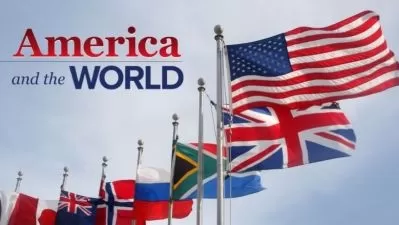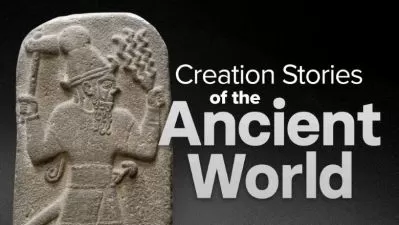Maya to Aztec: Ancient Mesoamerica Revealed
Edwin Barnhart
24:24:13
Description
Five hundred years ago, Spanish conquistadors searching for gold and new lands to settle stumbled on a group of independent city-states in Mesoamerica, a region extending for more than a thousand miles from the desert of northern Mexico to the rain forest of Central America. Sophisticated beyond the Spaniards’ wildest imaginings, these people were the Aztecs, the Maya, and related cultures that shared common traditions of religion, government, social organization, the arts, agriculture, engineering, and trade.
In many ways more advanced than European nations, these societies were the equal of the world’s greatest civilizations, with remarkable achievements including the following:
- Cities: The Aztec capital, Tenochtitlan, was more populous than any city in Europe and featured unprecedented public amenities, among them one of the largest public markets in the world.
- Time-keeping: The Maya created a calendar that could record their history down to the day over spans of thousands of years—a feat achieved by few other early civilizations.
- Foods: The most planted crop on Earth today, corn, was domesticated thousands of years ago in Mesoamerica, along with beans, squashes, chocolate, and other foods now consumed everywhere.
- Writing: Writing was independently invented just five times in the history of the world—once by the Maya, whose elaborate writing system was only deciphered in the late 20th century.
- Mathematics: Maya mathematics is so complex that we don’t yet know all it can do. The system is among the first ever to use zero, which is indispensible for practical and advanced calculations.
But the ancient Mesoamericans were also deeply mystifying. Their art was filled with strange images of serpents, birds, jaguars, and humans with fantastically adorned headdresses. Their cities were dominated by ceremonial pyramids, thousands of which were built throughout the region. Their most popular rituals included a bruising ball game played to propitiate the gods. And their most notorious practice was human sacrifice, performed frequently and sometimes with hundreds of victims slaughtered in a single ceremony.
Although the Spanish eventually conquered all of Mesoamerica, much remains of the original culture. Beautiful artifacts fill museums. Impressive ruins dot the landscape. And millions of descendants of ancient Mesoamericans still live in their ancestral homes, speaking native languages and practicing time-honored traditions. It’s no wonder that Mesoamerica is a must-see destination for travelers with an urge to step into an extraordinary past.
Maya to Aztec: Ancient Mesoamerica Revealed immerses you in this epic story with 48 exhilarating half-hour lectures that cover the full scope of Mesoamerican history and culture. Your guide is Professor Edwin Barnhart, Director of the Maya Exploration Center and a noted archaeologist, explorer, and teacher, whose exploits include the discovery of a lost Maya city.
The countries from Mexico to Costa Rica include more than a dozen UNESCO World Heritage Sites related to the pre-Columbian period, plus scores of other ancient sites that are equally worth a visit. These lectures are the ideal way to plan an itinerary, prepare for a tour, or simply sit back and enjoy a thrilling virtual voyage. You will be surprised at the number of sites to explore—many more than you could possibly see in months of travel.
Experience a Golden Age of Discovery
Among his many distinctions, Dr. Barnhart was a student of the famous Maya scholar Linda Schele, who played a pivotal role in deciphering the Maya script and helped spur a new understanding of this preeminent Mesoamerican civilization. In Maya to Aztec, you hear how the keys to deciphering the Maya hieroglyphs, which had frustrated generations of code breakers, suddenly fell into place at a conference organized by Schele in 1973. Since then, the marvelous world of the Maya has been revealed in far more rich detail, shedding new light on their history, mythology, rituals, monuments, and arts.
These discoveries, plus the exciting revelations of current archaeological work throughout Mesoamerica, make today a golden age of studies in the field and the perfect time to immerse yourself in this entrancing subject.
Maya, Aztec, and More…
The course focuses in depth on two cultures: the Maya, who have been in Mesoamerica for thousands of years, and the Aztecs, who mysteriously appeared late and rose swiftly to power. The Aztecs fell from power just as precipitously; their empire controlled the region for less than a century, until the arrival of the Spanish in the early 1500s. You learn what these two groups shared and what made them so different. For example, why did the Aztecs use chocolate beans for money yet apparently had gold for the taking, while the Maya had little interest in the metal so coveted by Europeans? And why were the Aztecs so quickly defeated by the conquistadors, while the Maya resisted the invaders for generations? In addition, you will see how the contrasting histories of the Aztecs and Maya continue to have repercussions in modern-day Mexico and Guatemala, helping to explain the complex politics of that part of the world.
Furthermore, ancient Mesoamerica was a crossroads of many different cultures, and you also learn about these major civilizations:
- Olmec: Famed for colossal stone heads, the Olmecs flourished more than 3,500 years ago and were one of Mesoamerica’s first complex societies. Study their beautiful and inscrutable art for clues about their way of life.
- Zapotec: The Zapotecs established one of the earliest major cities in Mesoamerica, Monte Alban, located on a strategic mountaintop overlooking the spectacular Valley of Oaxaca. Take a tour of the well-preserved ruins at this fascinating site.
- Mixtec: In 1932 an archaeologist at Monte Alban discovered a tomb as rich as an Egyptian pharaoh’s. But this was not a Zapotec grave; it belonged to a later people called the Mixtec. Learn about their culture and their powerful ruler called Eight Deer Jaguar Claw.
- Toltec: Revered by the Aztecs and more recently the purported source of mystical teachings, the Toltecs are one of the great question marks of Mesoamerican history. Investigate what is actually known about this enigmatic culture.
- Tarascan: A rival power to the Aztecs, the Tarascans have traits that connect them to the Inca in Peru. Discover that they are not the only Mesoamerican civilization with intriguing links to peoples far to the south and north.
Investigate the Controversies
Maya to Aztec is richly illustrated with Professor Barnhart’s own photos taken in the field, along with museum-grade images of artifacts, illustrations recreating ancient cities and temples, maps showing where to find different sites, and graphics that decode Mesoamerican writing and iconography.
Steeped in this subject for his entire professional career, Dr. Barnhart knows the arguments on all sides of the most important controversies, and he often has his own well-thought-out theories to contribute, making this course an exciting glimpse of exploration, theorizing, and discovery in action.
Among the mysteries and controversies you investigate are these:
- The Maya calendar: The elaborate time-keeping inscriptions of the Maya have sparked many sensational interpretations, such as a purported end of world in 2012. Dr. Barnhart shows that the true meanings involved rebirth, a cyclical view of history, and major turning points in Maya civilization.
- Human sacrifice: No subject so shocked outside observers, including the ruthless conquistadors, as human sacrifice. The key is to see this ritual in its broader religious context, which included auto-sacrifice—or self-mutilation—practiced by the ruling elite.
- Ball game: American football has been around for 150 years, but the Mesoamerican ball game has been played for 3,500 years. Explore the debate over the social functions of this risky sport, which used a solid rubber ball weighing as much as nine pounds.
- Maya collapse: Why would a civilization at the height of power systematically abandon its cities? Dr. Barnhart discusses the leading theories and then looks at evidence that the Maya obsession with cycles of time may have been the decisive factor.
- Ancient observatory: The massive tower called El Caracol in the Maya city of Chichen Itza is thought to be an ancient astronomical observatory. But how was it used? Are the many celestial alignments connected with it intentional or accidental?
Professor Barnhart also spotlights the momentous encounter that transformed Mesoamerica forever. Near the end of the course, he describes the march of Hernán Cortés and his small army of Spanish troops from Veracruz to the Aztec capital at Tenochtitlan in 1519. There the Aztec ruler, Moctezuma II, welcomed the foreigners with gifts of gold. Heedless of the Aztecs’ vastly superior strength, Cortés waged war and in less than two years defeated the entire Aztec empire. Dr. Barnhart evaluates the conflicting historical accounts of this astonishing conquest, which had a profound impact on the New World and the Old.
One who was affected was the great German artist Albrecht Dürer. In 1520 he visited Brussels and saw an exhibit of Aztec artifacts sent to the Holy Roman Emperor by Cortés. “All the days of my life,” Dürer wrote in his diary, “I have seen nothing that rejoiced my heart so much as these things, for I saw amongst them wonderful works of art, and I marveled at the subtle ingenuity of men of foreign lands.”
With Maya to Aztec, you, too, will marvel at the accomplishments and genius of an exceptional group of civilizations, which were among the greatest the world has ever known.
More details
User Reviews
Rating
Edwin Barnhart
Instructor's CoursesDr. Edwin Barnhart is director of the Maya Exploration Center. He holds a Ph.D. from the University of Texas at Austin and has over 20 years of experience in North, Central, and South America as an archaeologist, explorer, and instructor. In 1994, Professor Barnhart discovered the ancient city of Maax Na (Spider-Monkey House), a major center of the Classic Maya period in northwestern Belize. In 1998 he was invited by the Mexican government to direct the Palenque Mapping Project, a three-year effort to survey and map the unknown sections of Palenque's ruins. The resultant map has been celebrated as one of the most detailed and accurate ever made of a Maya ruin. In 2003, he became the director of Maya Exploration Center, a nonprofit organization dedicated to the study of ancient Maya civilization. The center leads study-abroad courses for college students and tours for the general public in the ruins of the ancient Americas, among its other research and educational activities. Professor Barnhart has taught archaeology and anthropology at Southwest Texas State University, and currently teaches University of Texas travel courses for college professors on ancient Andean and Mesoamerican astronomy, mathematics, and culture. Over the last 10 years, he has appeared multiple times on the History Channel, the Discovery Channel, and Japanese NHK Public Television. He has published over a dozen papers and given presentations at eight international conferences.

The Great Courses
View courses The Great Courses- language english
- Training sessions 48
- duration 24:24:13
- English subtitles has
- Release Date 2023/06/06
















